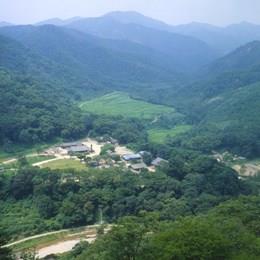기림사
| 기림사 Girimsa Temple |
|
 기림사, 한국민족문화대백과사전, 한국학중앙연구원. |
|
| 대표명칭 | 기림사 |
|---|---|
| 영문명칭 | Girimsa Temple |
| 한자 | 祇林寺 |
| 주소 | 경상북도 경주시 양북면 호암리 419번지 |
|
|
|
해설문
국문
기림사는 신라 때 인도 승려인 광유(光有)가 창건하고 이름은 임정사(林井寺)라고 했다. 643년에 원효가 중창한 뒤 기림사로 이름을 바꾸었다고 전해지는데, 기림사는 석가모니의 기원정사(祇園精舍)에서 ‘기’자를, 임정사에서 ‘임’자를 따온 것이라 한다.
『삼국유사』에는 신문왕(681~692 재위)이 문무대왕릉이 있는 동해 바다에서 용왕으로부터 만파식적(萬波息笛)과 옥대(玉帶)를 선물로 받고 돌아오는 길에 기림사 서쪽에서 쉬었다는 기록이 나온다. 따라서 창건 연대는 적어도 신문왕대 이전으로 올라간다.
임진왜란 때는 전략적 요충지이자 승병 운동의 중심지였다. 조선 철종 14년인 1863년에 화재로 소실된 후 중건한 건물들이 남아 있다. 조선 후기의 대표적인 불전 양식을 볼 수 있는 대적광전(大寂光殿, 보물 제833호), 진남루(鎭南樓), 약사전(藥師殿), 김시습의 사당인 매월당영당(梅月堂影堂) 등과 기림사 삼층석탑(유형문화재 제205호), 목탑지가 있다.
기림사는 전쟁의 피해를 거의 입지 않아 건칠보살반가상(乾漆菩薩半跏像, 보물 제415호), 소조비로자나삼불좌상(塑造毘盧遮那三佛坐像, 보물 제958호) 등 많은 문화재 외에도 문적과 어필(御筆)이 많이 남아있어 함월전시관을 건립하여 보관하고 있다.
영문
Girimsa Temple
Girimsa Temple is said to have been founded during the Silla period (57 BCE-935 CE) by a Buddhist monk from India known as Gwangyu in Korean. It was first known as Imjeongsa, meaning “Temple of the Forest Well.” It is said when the temple was expanded by the monk Wonhyo (617-686) in 643, the temple’s name was changed to its current one. The name is said to be a portmanteau using the first character in the name of the Jetavana Monastery in India (called Giwonjeongsa in Korean) where the Buddha gave many teachings and the first character (im/rim) of the temple’s original name.
There is a record that King Sinmun (r. 681-692) rested to the west of this temple on his return from visiting the tomb of his father King Munmu (r. 661-681) at the East Sea, where he had received a reed flute and jade belt from the Dragon King.
During the Japanese invasions of 1592-1598, the temple was a strategic base for soldier-monks. In 1863, all but a few major buildings were lost in a fire. Among these are Daejeokgwangjeon Hall (Treasure No. 833), Jinnamnu Pavilion, Yaksajeon Hall, and the Shrine of Kim Gi-seup. The temple also has a three-story stone pagoda (Gyeongsangbuk-do Tangible Cultural Heritage No. 205) and the site of a wooden pagoda.
As Girimsa Temple suffered little damage from war, it is also home to several Buddhist statues such as a dry-lacquered bodhisattva (Treasure No. 415) and a clay seated Vairocana Buddha triad (Treasure No. 958), as well as other historical documents and royal calligraphy which are kept at the Hamwol Exhibition Hall.
